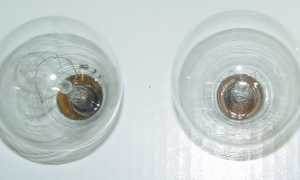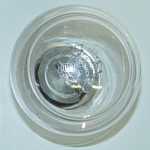Willis Lamm's
|
| Traffic Signal Bulbs |
|
One critical factor was known as light center length or LCL. LCL is the distance from the bottom of the bulb's base to the filament. The filament had to be in the correct location for a particular reflector design to project the bulb's light correctly onto the lens. For 8-3/8 inch reflectors the correct LCL is 2-7/16 inches. For 12 inch reflectors the correct LCL is 3 inches.
Additionally, in an effort to reduce sun phantoms (lenses appearing to be lit due to early morning or late afternoon un) most lenses had beads on the inside designed to primarily pick up light from below the bead. Older bulbs had horseshoe shaped filaments. It was necessary to adjust the bulbs so that the horseshoe was oriented like the letter "U" (closed at the bottom) to properly light the lens and eliminate a dark shadow on the bottom. Many newer bulbs have "M" shaped filaments (or "W" shaped filaments, depending on how you look at the bulb) filaments that reduce shadowing if the bulb isn't correctly oriented. In addition more modern bulbs also had small reflector discs below the filaments to eliminate a center "dark spot." |
L. Horseshoe filament, R. "M" filament.
|
Relative shapes and sizes of common signal bulbs.
Bulb Identifications:
|
|
1 150 Watt SP (Note 1) |
2 40 Watt GE |
3 51 Watt Phillips |
4 69 Watt Phillips |
5 69 Watt Duro Test |
|
6 60 Watt Sylvania (Note 2) |
7 67 Watt Duro Test |
8 67 Watt Sylvania |
9 68 Watt Hytron (Note 3) |
10 69 Watt Hytron |
|
11 116 Watt Duro Test |
12 135 Watt Hytron |
13 165 Watt GE |
|
Notes:
1. Used in 1, 2 and 3 bulb Darley signals where a single bulb lit four lenses. 2. Energy saver version of 69 watt bulb - using a different filament composite to provide same light with less wattage and still maintain long bulb life. 3. Extra long life bulb, guaranteed for two years. |
Common Signal Bulb Chart
| 40 Watts - | 410 Lumens | 100 Watts - | 1080 Lumens | |
| 60 Watts - | 550 Lumens | 116 Watts - | 1260 Lumens | |
| 67 Watts - | 610 Lumens | 135 Watts - | 1570 Lumens | |
| 69 Watts - | 630 Lumens | 150 Watts - | 1900 Lumens | |
| 90 Watts - | 1040 Lumens | 165 Watts - | 1950 Lumens |


